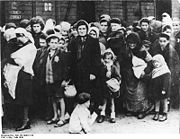- Ohrdruf concentration camp
-
 U.S. Generals Eisenhower, Bradley and Patton inspect a cremation pyre at the camp on April 12, 1945, after liberation
U.S. Generals Eisenhower, Bradley and Patton inspect a cremation pyre at the camp on April 12, 1945, after liberation
Ohrdruf concentration camp was a Nazi forced labor and concentration camp located near Weimar, Germany. It was part of the Buchenwald concentration camp network and the first Nazi concentration camp liberated by U.S. troops.[1]
Contents
History
Created in November 1944 near the town of Gotha, Germany, Ohrdruf supplied forced labor in the form of concentration camp prisoners for railway construction leading to a proposed communications center, which was never completed due to the rapid American advance.[2][3]
In late March 1945, the camp had a prisoner population of some 11,700, but in early April the SS evacuated almost all the prisoners on death marches to Buchenwald. The SS guards killed many of the remaining prisoners who were too ill to walk to the railcars.[4]
Liberation
Ohrdruf was liberated on April 4, 1945, by the 4th Armored Division and the 89th Infantry Division. It was the first Nazi concentration camp liberated by the U.S. Army.[5]
When the soldiers of the 4th Armored Division entered the camp, they discovered piles of bodies, some covered with lime, and others partially incinerated on pyres. The ghastly nature of their discovery led General Dwight D. Eisenhower, Supreme Commander of the Allied Forces in Europe, to visit the camp on April 12, with Generals George S. Patton and Omar Bradley. After his visit, Eisenhower cabled General George C. Marshall, the head of the Joint Chiefs of Staff in Washington, describing his trip to Ohrdruf:
. . .the most interesting--although horrible--sight that I encountered during the trip was a visit to a German internment camp near Gotha. The things I saw beggar description. While I was touring the camp I encountered three men who had been inmates and by one ruse or another had made their escape. I interviewed them through an interpreter. The visual evidence and the verbal testimony of starvation, cruelty and bestiality were so overpowering as to leave me a bit sick. In one room, where they were piled up twenty or thirty naked men, killed by starvation, George Patton would not even enter. He said that he would get sick if he did so. I made the visit deliberately, in order to be in a position to give first-hand evidence of these things if ever, in the future, there develops a tendency to charge these allegations merely to 'propaganda.'
Seeing the Nazi crimes committed at Ohrdruf made a powerful impact on Eisenhower, and he wanted the world to know what happened in the concentration camps. On April 19, 1945, he again cabled Marshall with a request to bring members of Congress and journalists to the newly liberated camps so that they could bring the horrible truth about Nazi atrocities to the American public. That same day, Marshall received permission from the Secretary of War, Henry Lewis Stimson, and President Harry S. Truman for these delegations to visit the liberated camps.[4]
Ohrdruf made a powerful impression on General George S. Patton as well. He described it as "one of the most appalling sights that I have ever seen." He recounted in his diary that
In a shed . . . was a pile of about 40 completely naked human bodies in the last stages of emaciation. These bodies were lightly sprinkled with lime, not for the purposes of destroying them, but for the purpose of removing the stench. When the shed was full--I presume its capacity to be about 200, the bodies were taken to a pit a mile from the camp where they were buried. The inmates claimed that 3,000 men, who had been either shot in the head or who had died of starvation, had been so buried since the 1st of January. When we began to approach with our troops, the Germans thought it expedient to remove the evidence of their crime. Therefore, they had some of the slaves exhume the bodies and place them on a mammoth griddle composed of 60-centimeter railway tracks laid on brick foundations. They poured pitch on the bodies and then built a fire of pinewood and coal under them. They were not very successful in their operations because there was a pile of human bones, skulls, charred torsos on or under the griddle which must have accounted for many hundreds.[4]
Gallery of Ohrdruf after liberation
References
- ^ The 89th Infantry Division, United States Holocaust Memorial Museum
- ^ Geoffrey R. Walden (5 November 2008). "Secret Objects "Siegfried/Olga/Burg/Jasmin" in the Jonas Valley near Ohrdruf". Third Reich Ruins. http://www.thirdreichruins.com/jonastal.htm. Retrieved 24 Feb, 2009.
- ^ Raiber, Richard, Guide to Hitler's Headquarters, After The Battle, No.19, p. 2.
- ^ a b c "Ohrdruf". United States Holocaust Memorial Museum Holocaust Encyclopedia. http://www.ushmm.org/wlc/article.php?lang=en&ModuleId=10006131. Retrieved 2009-06-05.
- ^ Ohrdruf Camp Description
External links
- Scrapbookpages.com - Ohrdruf forced labor camp
- History of the 602nd Tank Destroyer Battalion - Description of the liberation by Raymond J. Young
- United States Holocaust Memorial Museum - Ohrdruf
- United States Holocaust Memorial Museum - The 89th Infantry Division - Liberation of Ohrdruf - Video (April 1945 silent)
- United States Holocaust Memorial Museum - The 89th Infantry Division
- Georgia Tech Library and Information Center - Witness to the Holocaust - Ohrdruf Camp Description
- Simmins, Chuck - The Ohrdruf Photos
Categories:
Wikimedia Foundation. 2010.










